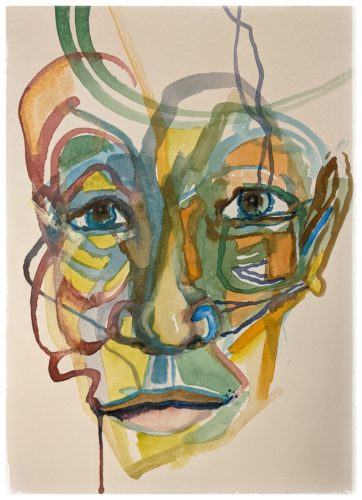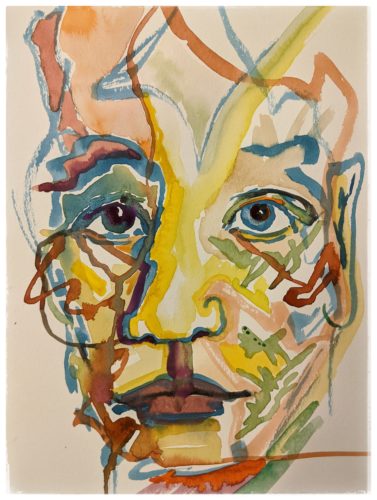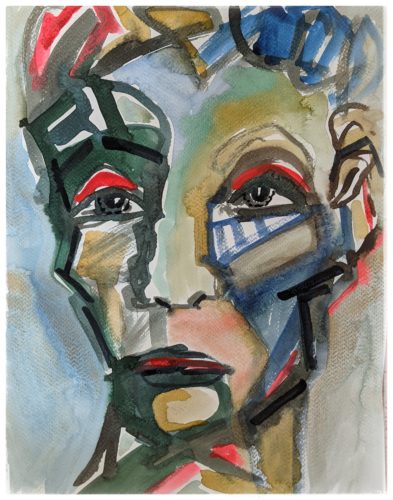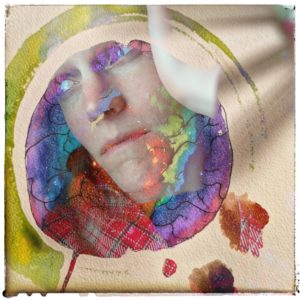
Sarah Kowalski is a writer, painter, and yoga teacher based in Philadelphia, PA. Her art and yoga teaching have always been motivated by a deep hunger to understand what it means to be alive in a human body and mind.
A lifelong writer, Sarah holds an undergraduate degree in creative writing from Swarthmore and an MFA in creative writing from the University of Southern Maine. A yoga teacher since 2014, she created a Yoga for Writers series that synthesized philosophy, physical practice, and writing community.
In 2020, Sarah sustained a life-changing concussion. As someone who was already a neuroplasticity and consciousness nerd, she has been fascinated, humbled, ripped apart and put back together again by this process of trauma recovery, and is immensely grateful for the role of art, embodiment work, and radical friendship in the healing process.
She’s more sure than ever that healing happens in relationship, and that the sacred practices of yoga, meditation, and artistic endeavor have the capacity not just to change our lives as individuals but to sustain us as we work for the changes we need to see in the world.
Sarah is deeply excited about sharing the practices of yoga, Buddhist meditation, and artistic practice as tools of gentle, step-by-step, breath-by-breath personal transformation.
Find her on instagram at @sarahtarrkowalski.
recent work











For as long as I can remember, I’ve doodled faces.
On the edges of notebooks. While listening to lectures. On tiny post-it notes.
I started painting them kind of by accident.
What happened was, one day in December 2020, I got out some watercolors to make a few Christmas cards. It was two months into my concussion recovery and life was… hard.
It hurt to look at light. I’d get swimmy whooshes of dizziness trying to look at a screen. It was also winter, in a pandemic. I couldn’t drive, and didn’t have anywhere to go even if I could. Even writing by hand, my lifelong respite, made me seasick.
What I discovered I could do?
Was paint. Like, a lot.
I ordered some watercolor paper and got a few brushes and paints at a local shop. I started painting obsessively, many paintings a day. Then, one day, I decided to try painting the way I doodle — and these faces emerged. And they just… haven’t stopped.
More about the faces:

A few days post-concussion, I’d started taking what I called “concussion portraits” — a series of selfies that were attempts to see whether various states of inner turmoil were legible on my face. They rarely were.
There is so much we can’t know or assume about one another just by looking. My writing has always been motivated by a churning sense that there is an ocean under the surface that we don’t express in our everyday encounters.
And yet, however much they show or hide, faces are so important to us that our brains devote a specific region to their recognition.
Mess with that specific bit of brain tissue? And your perception of faces could morph, shift, and even disappear.
The world we experience is always this co-creation, this co-arising, of perception and interconnection. What I mean is: no one else sees the world exactly the way you do. And what you see is always shifting.
A friend told me that he’d started looking at faces differently after seeing these paintings on Instagram.
The writer Jenny Odell calls this “attentional prosthesis” — a way that art can enable us to see with fresh eyes.
I think it’s a central reason I am so grateful for art: both making it and experiencing it. Art helps widen my capacity to experience the world. It helps me feel less alone in that inchoate sense of longing, that perpetual sense that there’s more going on than we can fully articulate, that perpetual sense of precious poignancy that is living in this world as a mortal being aware of our own awareness.
If it does that for you too, I’m super glad we found each other. Let’s stay in touch.
subscribe to my newsletter
updates on yoga classes, art, and writings; occasional musings on all things creativity, consciousness, and cultivating a practice.
